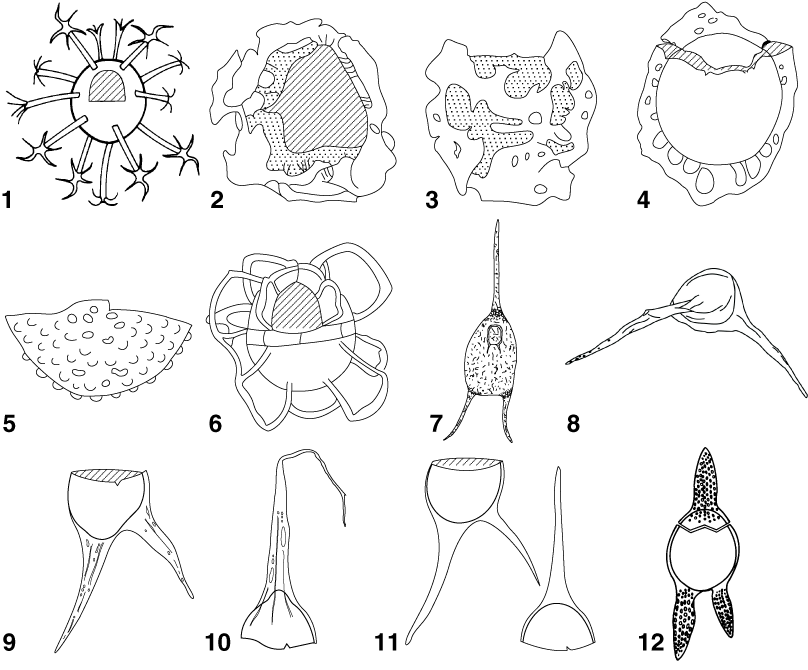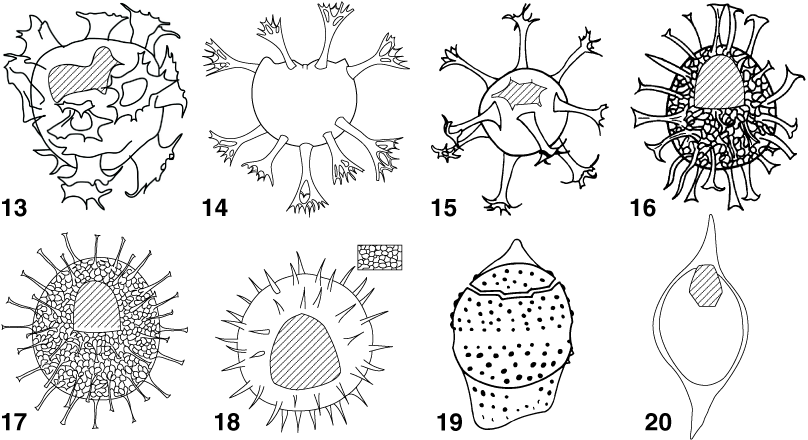
Plate P7. The modified Kofoid system (as outlined in Fensome et al., 1993b) is used in the labeling of individual plates for the gonyaulacaleans. The Kofoid system is used in the labeling of plates in the peridinialeans. The archeopyle location is denoted by diagonal lines. 1. Melitasphaeridium pseudorecurvatum (Morgenroth 1966a) Bujak et al. 1980. Dorsal view. Holotype dimensions: central body diameter = 34 Ám. 2, 3. Membranilarnacia? picena Biffi and Manum 1988. Holotype dimensions: overall width = 49 Ám, central body length (excluding processes) = 40 Ám, ectophragm separation = 8 Ám; (2) apical view; (3) lateral view. 4. Membranophoridium perforatum Wilson 1988. Ventral view. Holotype dimensions: overall length = 97 Ám, overall width = 80 Ám, endocyst length = 69 Ám, endocyst width = 61 Ám. 5. "Mendicodinium robustum" Zevenboom and Santarelli in Zevenboom 1995 (considered an unpublished manuscript name by the originating authors). Ventral view of hypocyst. Range of type material: length = 80–90 Ám, width = 80–90 Ám, wall thickness = 5–6 Ám. 6. Nematosphaeropsis downiei Brown 1986. Dorsal view. Holotype dimensions: overall length = 95 Ám, overall width = 88 Ám, central body length = 65 Ám, central body width = 60 Ám, process length = 28–30 Ám. 7. Octodinium askiniae Wrenn and Hart 1988. Dorsal view. Range of type material: pericyst width = 21–39 Ám, apical horn length up to 54 Ám, antapical horn length up to 36 Ám, endocyst length = 44–57 Ám, endophragm thickness < 0.5 Ám. 8. "Odontochitina diversa" Pearce 2000 (unpublished thesis name). Lateral view. 9, 10. Odontochitina costata Alberti 1961. Both dorsal view. Holotype dimensions: pericyst length = 522 Ám, central body diameter = 88 Ám. 11. Odontochitina operculata (O. Wetzel 1933a) Deflandre and Cookson 1955. Dorsal view. Holotype dimensions: pericyst length = 210 Ám, pericyst width = 170 Ám. 12. Odontochitina porifera Cookson 1956. Dorsal view. Holotype dimensions: pericyst length = 208 Ám, pericyst width = 78 Ám. 13. Oligosphaeridium poculum Jain 1977b. Oblique apical view. Holotype dimensions: central body diameter (excluding processes) = 80 Ám, process length = 6 Ám, process width proximally = up to 16 Ám, process width distally = up to 24 Ám. 14. Oligosphaeridium pulcherrimum (Deflandre and Cookson 1955) Davey and Williams 1966b. Dorsal view. Holotype dimensions: overall diameter = 118 Ám, central body diameter = 47 Ám x 61 Ám, process length = 26–38 Ám. 15. Oligosphaeridium sp. Oblique apical view. 16. Operculodinium divergens (Eisenack 1954b) Stover and Evitt 1978. Dorsal view. Holotype dimensions: overall diameter = 124 Ám, central body diameter = 71 Ám. 17. Operculodinium echigoense Matsuoka 1983b. Dorsal view. Holotype dimensions: central body diameter = 72 Ám, process length = 12 Ám. 18. Operculodinium? eirikianum Head et al. 1989b. Dorsal view. Holotype dimensions: central body diameter = 34 Ám, process length = 8–9 Ám. 19. Ovoidinium verrucosum (Cookson and Hughes 1964) Davey 1970. Dorsal view. Holotype dimensions: overall length = 52 Ám, overall width = 32 Ám. 20. Palaeocystodinium bulliforme Ioannides 1986. Dorsal view. Range of type material: pericyst length (excluding end spine) = 179–240 Ám, pericyst width = 64–120 Ám, endocyst length = 80–125 Ám, endocyst width = 60–102 Ám, end spine = up to 7 Ám long, pericoel width = up to 6 Ám x 28 Ám at base of horns, periphragm thickness = up to 1.5 Ám.





![]()